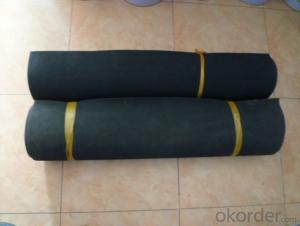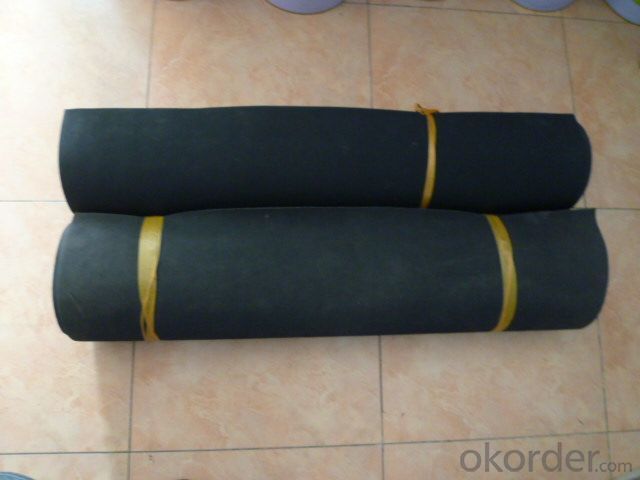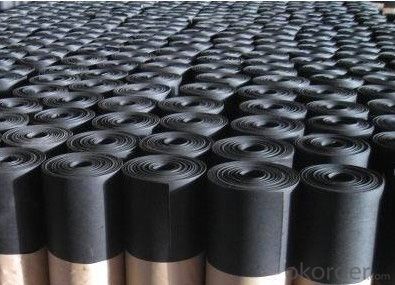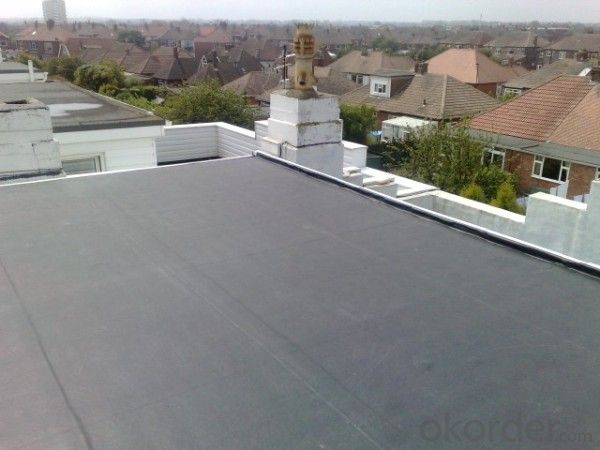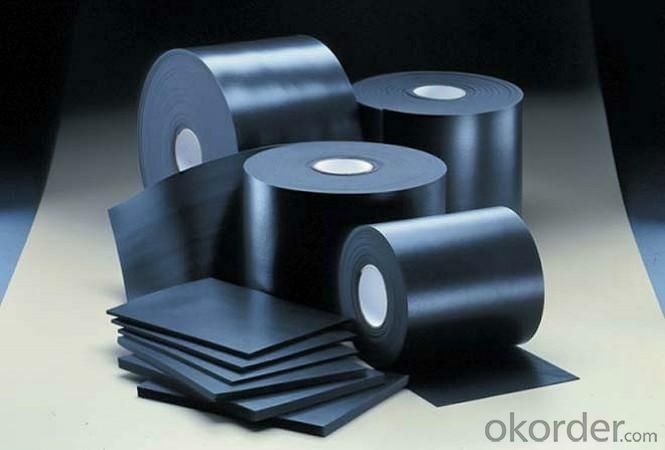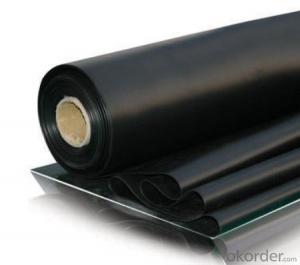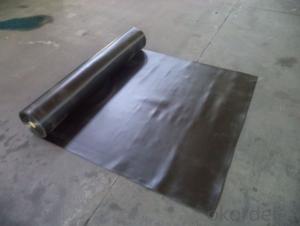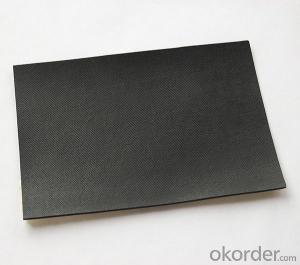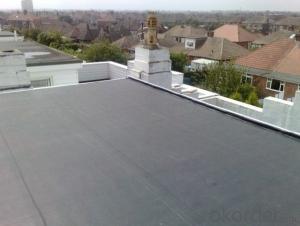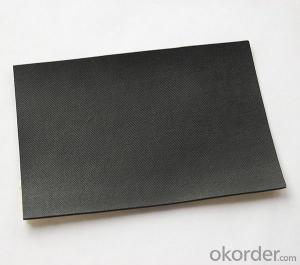EPDM Waterproof Membrane with Weldable for Road
- Loading Port:
- Shanghai
- Payment Terms:
- TT OR LC
- Min Order Qty:
- 50000 m²
- Supply Capability:
- 5000000 m²/month
OKorder Service Pledge
OKorder Financial Service
You Might Also Like
EPDM Waterproof Membrane with Weldable for Road
Description Of EPDM Waterproof Membrane with Weldable for Road:
1. Excellent physical and mechanical performance, high tearing resistance;good deformation adaptability, high puncture resistance;
2. High aging resistance, high UV resistance, anti-acid & alkali;
3. Excellent low & high temperature resistance, innocuous, long life span;
4. Perfect water proof performance, seepage and humidity resistance.
Main Features of EPDM Waterproof Membrane with Weldable for Road:
A.Polyester based SBS Modified Bitumen Waterproofing Membrane
a. Strong impermeability
b. High tensile strength, elongation, ability to adapt the grassroots shrinkage deformation and cracking
c. Puncture-resistant, broken resistant, tear-resistant
d. The corrosion resistance, resistance to mildew, weathering good
e. Construction convenient, hot-melt can be operated Four Seasons Construction, reliable joints
B. Fiberglass based SBS Modified Bitumen Waterproofing Membrane
a. High tensile strength, stability of a good size
b. High Temperature good performance
c. Damage resistance, corrosion resistance, resistance to mildew, weathering good performance
d. Good construction performance, reliable joints.
Specifications of EPDM Waterproof Membrane with Weldable for Road:
| Material | EPDM Rubber |
| Size | 1.2m (width)*20m (length) or customized, weldable type 2.05m or 4m width |
| Thick | 1.2mm, 1.5mm, 2.0mm |
| Type | Vulcanized & Weldable |
| Pattern | Non-reinforced (homogeneous) |
| Certificate | ISO9001/14001 |
Applications of EPDM Waterproof Membrane with Weldable for Road:
geomembrane used in groundsill of road, highway, railway and waterproof layer of swelling clay and wet collapsed loess.Geomembrane can be widely used in areas of garbage burying, waste disposal and underground construction projects.such as below:
- aquaculture ponds
- Ouchi root barrier membrane
- Floating baffles;
- Process wastewater
- Stormwater impoundments;
- Secondary containment;
- Spill containment
- Manure and biogas tanks and covers
- Potable water tanks and covers;
- Sludge Drying beds;
- Bioremediation covers & liners;
- Leachate ponds



IMages of EPDM Waterproof Membrane with Weldable for Road:




FAQ of EPDM Waterproof Membrane with Weldable for Road:
1. What are we supplying?
We are specialized in producing Colorful Asphalt Roof Shingle, SBS/APP modified bitumen waterproof membrane, Self adhesive bitumen waterproof membrane, PVC waterproofing membrane, EPDM rubber roofing membrane, Single Component Polyurethane Waterproof Coating, and Spray Polyurea Waterproof Coating
.
2. How Many years experience do we have?
We have been exported to more than 20 countries in the past 15 years.
3. How long do we usually reply your request?
We always reply our customer within 24 hours.
- Q: Can a waterproofing membrane be used for podium decks or plaza areas?
- Yes, a waterproofing membrane can be used for podium decks or plaza areas. Waterproofing membranes are commonly used in construction to prevent water penetration and protect the underlying structure from moisture damage. In outdoor areas like podium decks or plaza areas, where exposure to rain or other forms of water is common, a waterproofing membrane can provide an effective barrier against water infiltration and help maintain the integrity of the deck or plaza surface.
- Q: Can a waterproofing membrane be used in residential buildings?
- Yes, a waterproofing membrane can be used in residential buildings. It is commonly used in basements, bathrooms, and other areas prone to moisture to prevent water damage and leakage.
- Q: Can a waterproofing membrane be used in swimming pools or water features?
- Swimming pools or water features can benefit from the use of a waterproofing membrane. This type of membrane is commonly employed in these scenarios to establish a barrier between the water and the surrounding structure. By doing so, it prevents any water leakage and structural damage, ultimately ensuring the swimming pool or water feature's longevity and durability. Typically, the membrane is applied to the structure's surface and can be composed of various materials like rubber, PVC, or bitumen. It is imperative to select a membrane specifically designed for underwater applications to guarantee its effectiveness in providing a watertight seal. Furthermore, proper installation and regular maintenance of the waterproofing membrane are vital to uphold its long-term performance.
- Q: How does a waterproofing membrane handle seismic movements?
- A waterproofing membrane is designed to provide protection against water intrusion and leaks in structures such as buildings, basements, or roofs. While its primary function is to prevent water damage, it also plays a role in handling seismic movements to some extent. Seismic movements, or earthquakes, can cause significant stress and strain on structures, leading to cracks, fissures, or even the complete collapse of buildings. These movements generate intense vibrations and ground motion, which can compromise the integrity of waterproofing systems. In response to seismic movements, a properly installed waterproofing membrane is designed to be flexible and elastic. It can absorb and distribute the energy generated by the ground motion, minimizing the impact on the structure and reducing the likelihood of water infiltration. One way a waterproofing membrane handles seismic movements is through its ability to elongate and stretch. During an earthquake, the membrane can deform and accommodate the movement of the structure without tearing or breaking. This flexibility allows it to maintain its waterproofing capabilities even under extreme conditions. Additionally, waterproofing membranes often incorporate reinforcement layers, such as polyester or fiberglass, to enhance their tensile strength and resistance to tearing. These reinforcement layers help the membrane withstand the dynamic forces exerted during seismic events, ensuring its integrity and preventing water from seeping into the structure. It is important to note that while a waterproofing membrane can handle seismic movements to a certain extent, it is not a substitute for proper structural design and earthquake-resistant construction practices. Structures should be engineered to withstand seismic forces, and waterproofing systems should be installed in accordance with industry standards and guidelines to ensure their effectiveness and durability during earthquakes. In conclusion, a waterproofing membrane can handle seismic movements by being flexible, elastic, and resistant to tearing. It absorbs and distributes the energy generated by seismic events, protecting the structure from water infiltration and minimizing potential damage. However, it is essential to combine proper structural design and construction techniques with a reliable waterproofing system to ensure overall safety and resilience during earthquakes.
- Q: Can a waterproofing membrane be used for highway or road projects?
- Yes, a waterproofing membrane can be used for highway or road projects. It acts as a protective layer against water infiltration, preventing damage to the road structure and increasing its lifespan. Additionally, it helps to reduce maintenance costs and provides a smoother and safer driving surface.
- Q: Are waterproofing membranes resistant to acid rain?
- Yes, waterproofing membranes are generally resistant to acid rain. Waterproofing membranes are designed to provide a barrier against water penetration, and they are typically made from materials that are resistant to various environmental factors, including acid rain. Acid rain is caused by the emission of sulfur dioxide and nitrogen oxide pollutants, which react with water vapor in the atmosphere to form sulfuric and nitric acids. These acids can corrode and damage certain materials over time, but waterproofing membranes are specifically engineered to withstand acid rain and other environmental stresses. They are commonly made from materials such as modified bitumen, thermoplastic polyolefin (TPO), ethylene propylene diene monomer (EPDM), or polyvinyl chloride (PVC), which have high resistance to acid rain. Additionally, some waterproofing membranes may have additional protective coatings or additives that enhance their resistance to acid rain, ensuring long-term durability and performance. However, it is important to note that the exact resistance level of a waterproofing membrane to acid rain may vary depending on the specific product and manufacturer, so it is always recommended to consult the manufacturer's guidelines or specifications for accurate information.
- Q: Can a waterproofing membrane be used for pond or pool applications?
- Yes, a waterproofing membrane can be used for pond or pool applications. Waterproofing membranes are designed to provide a barrier against water penetration, making them an ideal choice for sealing ponds and pools. These membranes are typically made from synthetic materials such as PVC, EPDM, or TPO, which are highly resistant to water and UV rays. They are available in various thicknesses and can be customized to fit the specific dimensions of the pond or pool. Additionally, waterproofing membranes are durable and flexible, allowing them to withstand the constant exposure to water and the movement of the underlying substrate. Overall, using a waterproofing membrane for pond or pool applications can help prevent leaks, prolong the lifespan of the structure, and ensure a safe and enjoyable water environment.
- Q: Can a waterproofing membrane be used for food processing facilities?
- Yes, a waterproofing membrane can be used for food processing facilities. These membranes are specifically designed to prevent water penetration and can be installed in areas where food is processed to ensure a hygienic and moisture-resistant environment.
- Q: Can a waterproofing membrane be used on asphalt surfaces?
- Yes, a waterproofing membrane can be used on asphalt surfaces. Waterproofing membranes are often used to protect various surfaces, including asphalt, from water damage. They create a barrier that prevents water from seeping into the asphalt, reducing the risk of cracks, deterioration, and other forms of damage caused by moisture.
- Q: Can a waterproofing membrane be used for parking garages?
- Yes, a waterproofing membrane can be used for parking garages. A waterproofing membrane is a protective layer that is applied on surfaces to prevent water penetration. In parking garages, it is essential to have effective waterproofing to protect the structure from water damage, such as corrosion of steel reinforcement and deterioration of concrete. Parking garages are exposed to various sources of water, including rain, snow, and vehicle fluids, which can seep through cracks and joints. A waterproofing membrane acts as a barrier, preventing water from infiltrating the structure and causing damage. There are different types of waterproofing membranes available for parking garages, including sheet membranes, liquid-applied membranes, and cementitious coatings. These membranes can be applied on horizontal and vertical surfaces, such as floors, walls, and ramps, to create a watertight seal. When selecting a waterproofing membrane for a parking garage, factors such as durability, flexibility, and resistance to chemicals should be considered. The membrane should be able to withstand the heavy loads and traffic conditions typically found in parking garages. Overall, using a waterproofing membrane in parking garages is crucial to protect the structure and extend its lifespan by preventing water-related damage. It helps maintain the structural integrity and aesthetics of the garage while ensuring a safe and functional environment for users.
Send your message to us
EPDM Waterproof Membrane with Weldable for Road
- Loading Port:
- Shanghai
- Payment Terms:
- TT OR LC
- Min Order Qty:
- 50000 m²
- Supply Capability:
- 5000000 m²/month
OKorder Service Pledge
OKorder Financial Service
Similar products
Hot products
Hot Searches
Related keywords
